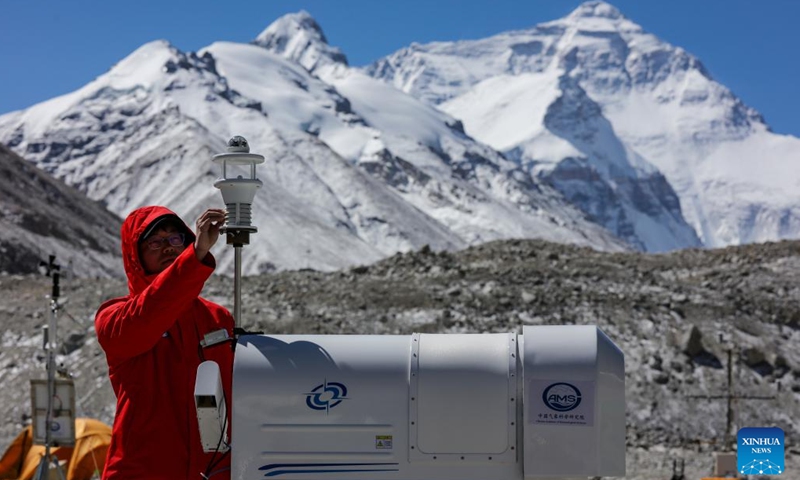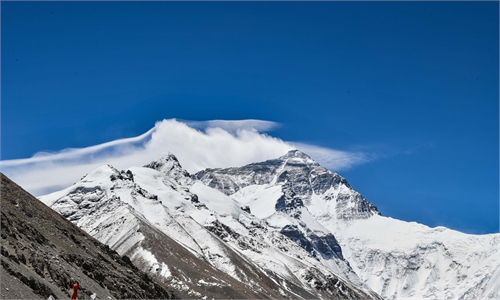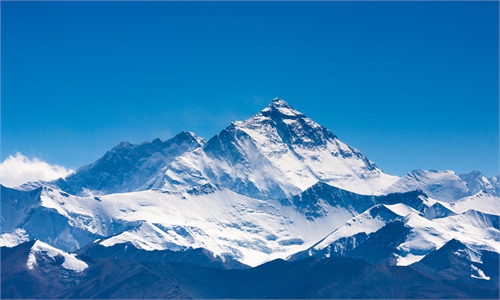China sets up world's highest automatic weather station at over 8,800m altitude on Mount Qomolangma
Warriors successfully establish world's highest automatic weather station


A scientific research member checks a microwave radiometer at the Mount Qomolangma base camp on May 3, 2022.Photo:Xinhua
Once again, China has conquered the world's highest peak, Mount Qomolangma, which is also known as Mount Everest in the West, on Wednesday. Thirteen members of the Chinese Earth Summit Mission 2022 scientific expedition team successfully established an automatic meteorological monitoring station at an altitude of over 8,800 meters, the world's highest of its kind, on Mount Qomolangma on the China-Nepal border, achieving the milestone task of the country's second comprehensive survey to the roof of the world.
The team of 13 warriors left their camp at the altitude 8,300 meters by 3 am on Wednesday and reached the designated height of 8,800 meters and established the automatic weather station by around 12:46 pm, according to China's state broadcaster China Central Television (CCTV), which covered their expedition live with a high resolution camera.
All 13 team members finally reached the summit at 13:28 pm and displayed the Chinese national flag proudly. The team also measured the thickness of ice and snow on the summit for the first time with high-precision radar, collected ice and snow samples, and carried out experiments on the adaptation mechanism of the human body to extremely high altitudes, according to CCTV.
News of the Chinese expedition's successful ascent of Mount Qomolangma and displaying the national flag became one of the top trending topics on China's Twitter-like social media, Sina Weibo, attracting more than 30 million views.
Dubbed "the roof of the world" and the "water tower of Asia," the Qinghai-Xizang Plateau is not only Earth's third pole but also a key ecological security barrier and a strategic resource reserve for China as well as an important conservation for the characteristic culture of the Chinese nation. The latest scientific expedition to the region is projected to help further explore the cause of plateau environmental changes and will play a crucial role in pushing forward the sustainable development of the Qinghai-Xizang Plateau and promoting construction of China's national ecological civilization as well as global ecological environmental protection, Yao Tandong, an academician of the Chinese Academy of Sciences, said when speaking to the media on Wednesday.
China launched the first Qinghai-Xizang comprehensive scientific research in the early 1970s and the second started in 2017.
According to Yao, who is also the Honorary Director of the Institute of Tibetan Plateau Research, Chinese Academy of Science, the first time was "descriptive" and aimed to find out what we have, but the second was to look at changes, and to provide evidence to support policymaking on improving the region's social and economic development and protection of local ecological environment.
The Wednesday charge to Mount Qomolangma is an integral part of the second comprehensive scientific research to the plateau. China has deployed five teams with 16 subordinate squads, more than 270 researchers, covering the widest range of disciplines with the largest scale of manpower since the initiation of the second comprehensive mission to the region.
The new automatic meteorological station at 8,800 meters above sea level replaces the station sitting at an altitude of 8,430 meters on the south side of the mountain, set up by British and US scientists in 2019, to become the world's highest, according to the Institute of Tibetan Plateau Research.
China now has eight stations set up from 5,200 meters to 8,800 meters on Mount Qomolangma, with four stations exceeding 7,000 meters respectively at 7,028 meters, 7,790 meters, 8,300 meters and 8,800 meters. The data collected by the new one will fill in the gap in meteorological records at extremely high altitudes on Mount Qomolangma, the Global Times learned from mission insiders.
These meteorological stations at different altitudes mainly monitor the temperature, relative humidity, wind direction, wind speed, pressure and radiation changes in the region, and can realize real-time remote transmission of data, they explained.
The automatic meteorological station will be used to research temperature and gradient changes in this region, and temperature and altitude changes in the Earth's third pole, CCTV reported. Meanwhile, it indicates that the establishment of a gradient meteorological observation system at Mount Qomolangma in China has been preliminarily completed, which is of great significance to monitor the changes in high-altitude glaciers and snowfall.
Conventional meteorological observations are generally below 5,000 meters and rarely above 5,000 meters, and such high-altitude meteorological observations are scarce at the moment, Zhao Huabiao, a researcher at the Institute of Tibetan Plateau Research, said on Wednesday.
"The reason for building a weather station at 8,800 meters instead of 8,848 meters is that the snow and ice on the summit are not suitable for fixing equipment, and in this regard, the weather station was built on bedrock around 8,800 meters which is convenient," said Zhao.
Automatic meteorological stations are powered by solar panels and can be used for two years under normal circumstances, experts explained.
The growth of China's comprehensive power and the advancement of the country's science and technology have supported the upgrade of expedition gear. Yao said that devices such as drones, unmanned ships, sounding balloons and airships were deployed in the second probe, and helicopters have joined the task for the first time in history.
Yao noted that with the support of major state research programs, China has advanced to the first tier around the world in many domains, including research on glacier transformation and climate change. Yao said he believes that as China continues this research and shares the findings and new progress with the rest of the world, China will have more say in related fields.
A Chinese survey team reached the summit of Mount Qomolangma on May 27, 2020 and remeasured the peak height. Nepali surveyors reached the top of the mountain in May 2019.
In May 2020, eight Chinese warriors conquered the world's peak in a quest to measure the height of mountain, with the help of a range of China's homegrown technology such as BeiDou Satellite Navigation System and 5G communication technology.
And in December 2020, China and Nepal jointly announced the new height of Mount Qomolangma is 8,848.86 meters.




